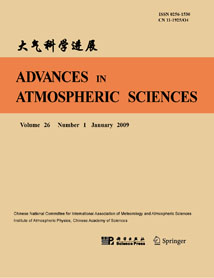| [1] |
YUE Xu, WANG Huijun, LIAO Hong, FAN Ke,
2010: Direct Climatic Effect of Dust Aerosol in the NCAR Community Atmosphere Model Version 3 (CAM3), ADVANCES IN ATMOSPHERIC SCIENCES, 27, 230-242.
doi: 10.1007/s00376-009-8170-z
|
| [2] |
WANG Zhili, ZHANG Hua, SHEN Xueshun,
2011: Radiative Forcing and Climate Response Due to Black Carbon in Snow and Ice, ADVANCES IN ATMOSPHERIC SCIENCES, 28, 1336-1344.
doi: 10.1007/s00376-011-0117-5
|
| [3] |
ZHANG Hua, ZHANG Ruoyu, and SHI Guangyu,
2013: An updated estimation of radiative forcing due to CO2 and its effect on global surface temperature change, ADVANCES IN ATMOSPHERIC SCIENCES, 30, 1017-1024.
doi: 10.1007/s00376-012-2204-7
|
| [4] |
WANG Hong, SHI Guangyu, LI Shuyan, LI Wei, WANG Biao, HUANG Yanbin,
2006: The Impacts of Optical Properties on Radiative Forcing Due to Dust Aerosol, ADVANCES IN ATMOSPHERIC SCIENCES, 23, 431-441.
doi: 10.1007/s00376-006-0431-5
|
| [5] |
Xiaoyan WU, Jinyuan XIN, Wenyu ZHANG, Chongshui GONG, Yining MA, Yongjing MA, Tianxue WEN, Zirui LIU, Shili TIAN, Yuesi WANG, Fangkun WU,
2020: Optical, Radiative and Chemical Characteristics of Aerosol in Changsha City, Central China, ADVANCES IN ATMOSPHERIC SCIENCES, 37, 1310-1322.
doi: 10.1007/s00376-020-0076-9
|
| [6] |
Hu Rongming, Serge Planton, Michel Déque, Pascal Marquet, Alain Braun,
2001: Why Is the Climate Forcing of Sulfate Aerosols So Uncertain?, ADVANCES IN ATMOSPHERIC SCIENCES, 18, 1103-1120.
doi: 10.1007/s00376-001-0026-0
|
| [7] |
Boru MAI, Xuejiao DENG, Zhanqing LI, Jianjun LIU, Xiang'ao XIA, Huizheng CHE, Xia LIU, Fei LI, Yu ZOU, Maureen CRIBB,
2018: Aerosol Optical Properties and Radiative Impacts in the Pearl River Delta Region of China during the Dry Season, ADVANCES IN ATMOSPHERIC SCIENCES, 35, 195-208.
doi: 10.1007/s00376-017-7092-4
|
| [8] |
YANG Fumo, Jeffrey BROOK, HE Kebin, DUAN Fengkui, MA Yongliang,
2010: Temporal Variability in Fine Carbonaceous Aerosol over Two Years in Two Megacities: Beijing and Toronto, ADVANCES IN ATMOSPHERIC SCIENCES, 27, 705-714.
doi: 10.1007/s00376-009-9103-6
|
| [9] |
SUN Zhian, WANG Xiaoyun, ZENG Xianning,
2006: Radiative Forcing of SO2 and NOx: A Case Study in Beijing, ADVANCES IN ATMOSPHERIC SCIENCES, 23, 317-322.
doi: 10.1007/s00376-006-0317-6
|
| [10] |
Hui XU, Jianping GUO, Jian LI, Lin LIU, Tianmeng CHEN, Xiaoran GUO, Yanmin LYU, Ding WANG, Yi HAN, Qi CHEN, Yong ZHANG,
2021: The Significant Role of Radiosonde-measured Cloud-base Height in the Estimation of Cloud Radiative Forcing, ADVANCES IN ATMOSPHERIC SCIENCES, 38, 1552-1565.
doi: 10.1007/s00376-021-0431-5
|
| [11] |
LIAO Hong, CHANG Wenyuan, YANG Yang,
2015: Climatic Effects of Air Pollutants over China: A Review, ADVANCES IN ATMOSPHERIC SCIENCES, 32, 115-139.
doi: 10.1007/s00376-014-0013-x
|
| [12] |
Li Xingsheng, Zhou Jianqiang, Li Zhe, Fang Xiumei, He Zhuanshi, Farn Parungo,
1998: A Numerical Simulation of “5.5” Super-Duststorm in Northern China, ADVANCES IN ATMOSPHERIC SCIENCES, 15, 63-73.
doi: 10.1007/s00376-998-0018-4
|
| [13] |
LI Shu, WANG Tijian, ZHUANG Bingliang, HAN Yong,
2009: Indirect Radiative Forcing and Climatic Effect of the Anthropogenic Nitrate Aerosol on Regional Climate of China, ADVANCES IN ATMOSPHERIC SCIENCES, 26, 543-552.
doi: 10.1007/s00376-009-0543-9
|
| [14] |
Bing XIE, Hua ZHANG, Zhili WANG, Shuyun ZHAO, Qiang FU,
2016: A Modeling Study of Effective Radiative Forcing and Climate Response Due to Tropospheric Ozone, ADVANCES IN ATMOSPHERIC SCIENCES, 33, 819-828.
doi: 10.1007/s00376-016-5193-0
|
| [15] |
CHE Huizheng, ZHANG Xiaoye, Stephane ALFRARO, Bernadette CHATENET, Laurent GOMES, ZHAO Jianqi,
2009: Aerosol Optical Properties and Its Radiative Forcing over Yulin, China in 2001 and 2002, ADVANCES IN ATMOSPHERIC SCIENCES, 26, 564-576.
doi: 10.1007/s00376-009-0564-4
|
| [16] |
FENG Qian, CUI Songxue, ZHAO Wei,
2015: Effect of Particle Shape on Dust Shortwave Direct Radiative Forcing Calculations Based on MODIS Observations for a Case Study, ADVANCES IN ATMOSPHERIC SCIENCES, 32, 1266-1276.
doi: 10.1007/s00376-015-4235-3
|
| [17] |
Yunfei FU, Jiachen ZHU, Yuanjian YANG, Renmin YUAN, Guosheng LIU, Tao XIAN, Peng LIU,
2017: Grid-cell Aerosol Direct Shortwave Radiative Forcing Calculated Using the SBDART Model with MODIS and AERONET Observations: An Application in Winter and Summer in Eastern China, ADVANCES IN ATMOSPHERIC SCIENCES, 34, 952-964.
doi: 10.1007/s00376-017-6226-z
|
| [18] |
Chenyu MA, Wei YUAN, Ji NIE,
2020: Responses of Mean and Extreme Precipitation to Different Climate Forcing Under Radiative-Convective Equilibrium, ADVANCES IN ATMOSPHERIC SCIENCES, 37, 377-386.
doi: 10.1007/s00376-020-9236-1
|
| [19] |
ZHANG Yi, and LI Jian,
2013: Shortwave Cloud Radiative Forcing on Major Stratus Cloud Regions
in AMIP-type Simulations of CMIP3 and CMIP5 Models, ADVANCES IN ATMOSPHERIC SCIENCES, 30, 884-907.
doi: 10.1007/s00376-013-2153-9
|
| [20] |
CHANG Wenyuan, LIAO Hong, WANG Huijun,
2009: Climate responses to direct radiative forcing of anthropogenic aerosols, tropospheric ozone, and long-lived greenhouse gases in eastern China over 1951-2000, ADVANCES IN ATMOSPHERIC SCIENCES, 26, 748-762.
doi: 10.1007/s00376-009-9032-4
|















 AAS Website
AAS Website 
 AAS WeChat
AAS WeChat 
 DownLoad:
DownLoad: